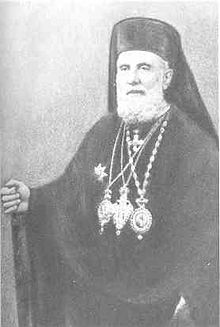Panteleimon Kotokos
 From Wikipedia - Reading time: 6 min
From Wikipedia - Reading time: 6 min
Panteleimon Kotokos | |
|---|---|
| Bishop of Gjirokastër | |
 | |
| Church | Orthodox Autocephalous Church of Albania |
| In office | 1937–1941 |
| Personal details | |
| Born | 1890 |
| Died | 24 May 1969 Athens, Greece |
Panteleimon of Gjirokastër (Greek: Παντελεήμων Αργυροκάστρου, born Christos Kotokos, Greek: Χρήστος Κοτόκος, Albanian: Kristo Kotoko; 1890–1969) was a bishop of the Orthodox Autocephalous Church of Albania. He was the metropolitan bishop of Gjirokastër (1937–1941) and later the President of the exiled Northern Epirus resistance faction KEVA after the end of World War II.[1][2]
Panteleimon Kotokos was born in Korçë, in the Manastir Vilayet of the Ottoman Empire (present-day southern Albania) in 1860, into a Greek family.[2] After he finished middle level education in his home place he was accepted in the Theological School of Halki, in Istanbul (Constantinople). For several years he worked as a high school theology teacher. He also acquired a degree in law science at the University of Athens.[3]
After an agreement with the Albanian authorities, in 1937, the Ecumenical Patriarchate chose a number of highly educated religious personalities for key position in the recently declared as autocephalous Orthodox Church of Albania. Among them were Panteleimon Kotokos as metropolitan of Gjirokastër and Eulogios Kourilas, as metropolitan of Korçë.[2]
When the communist regime of Enver Hoxha came to power in Albania (1945), he was declared 'enemy of the state' and was expelled from the country.[2] He fled to Greece where together with Eulohios Kourilas became the heads of the Central Committee of the Northern Epirote Struggle (KEVA). On November 18, 1945, he managed to organize a massive demonstration in Athens, where 150,000 people participated.[4] The following years he became active as a member of the exiled Northern Epirus lobby propagating discrimination of the Greek minority by the Communist regime of Albania.[5]
References
[edit]- ^ Kondis, Basil (1990). The Greeks of Northern Epirus and Greek-Albanian relations: historical review from the Greek edition : v. 3, 1922-1929-v. 4, 1930-1940. Hestia. p. 41. ISBN 9789600507416.
- ^ a b c d Fahlbusch, Erwin Bromiley, Geoffrey William (1999). The encyclopedia of Christianity. "Hestia" Publishers & Booksellers [Wm. B. Eerdmans Publishing]. p. 35. ISBN 978-88-89345-04-7.
{{cite book}}: CS1 maint: multiple names: authors list (link) - ^ Oikonomou, Phōtios G. (1988). Ē Orthodoxos Ekklēsia tēs Alvanias, 1912-1988 kai ē symvolē tēs eis tēn diatērēsin tou Ellēnismou tēs Voreiou Ēpeirou Η Ορθόδοξος Εκκλησία της Αλβανίας 1912-1988 και η συμβολή της εις στην διατήρηση του Ελληνισμού της Βορείου Ηπείρου (in Greek). Nea Thesis. p. 24.
- ^ Tönes, Bernhard (1983). "Belastungsprobe für die albanisch-griechischen Beziehungen". Südosteuropa - Zeitschrift für Gegenwartsforschung (in German). Südost-Institut München. Abteilung Gegenwartsforschung: 440–456 [442].
- ^ Stephanidēs Giannēs D.; Stefanidis Ioannis D. (2007). Stirring the Greek nation: political culture, irredentism and anti-Americanism in post-war Greece, 1945-1967. Ashgate Publishing, Ltd. pp. 40–115. ISBN 978-0-7546-6059-0.
 KSF
KSF